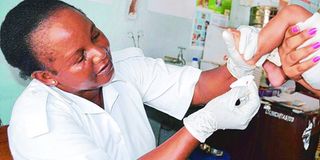Many East Africans missing out on disease diagnosis

By Wilber Sabiti
Early diagnosis is crucial for the effective management of any disease. In Africa, this isn’t always possible which affects the ability of countries to bring diseases under control.
My colleagues and I conducted research into the barriers to diagnosis for tuberculosis (TB) in Kenya, Tanzania and Uganda. We also wanted to identify what opportunities there were to maximise the use of diagnostics in healthcare settings.
We found that, in all three countries, the uptake of diagnostics was highest – over 90 percent – at large referral hospitals in major municipalities and cities, what we call “tertiary level health care facilities”. Lower level health care facilities, where most people live, were less served by diagnostic tests.
This has serious implications for the management of diseases.
The study was completed prior to emergence of Covid-19. But a similar trend of over concentration of diagnostics in major cities has been repeated in Covid-19 responses in all the three countries. For instance, in Kenya 26 out of 47 Covid-19 PCR (polymerase chain reaction) testing laboratories are in Nairobi, while in Uganda 17 out of 22 are in Kampala. Until recently Tanzania had one national testing laboratory in Dar es Salaam. Five more laboratories have been approved for PCR testing.
This raises the question of the extent to which Covid-19 testing has been accessed by the rural communities of the three countries.
From our research, we concluded that each country needed to pursue solutions to unlock barriers to increase access to diagnostics. Countries must be encouraged to distribute essential healthcare provision – like diagnosis – to where people most need them and where they can be accessed more easily.
In addition, solutions must include increased domestic financing to improve healthcare at primary healthcare level; mass education to increase awareness of the available diagnostic and treatment tools and investing in community empowerment solutions.
Kenya, Tanzania and Uganda were ideal for the study because they have relatively similar administrative and health system structures. They are also high TB burden countries.
The health systems in the study countries vary, and grow in size and services in relation to the population they’re serving. They range from level one (the smallest) through to level five (the largest). For instance, at the village level there are small dispensaries or health centres (level 1) whereas at the city level there are large hospitals (level 5).
To assess the barriers to diagnosis we looked at the implementation of WHO approved molecular diagnostics for TB – Xpert MTB/RIF and Line Probe Assay tests.
We spoke to a range of stakeholders. These included healthcare practitioners, patients, survivors, carers, community leaders, policy makers and implementers. We further inspected the participating healthcare centres to ascertain the existence of facilities referred to by practitioners in the interview.
The main barriers we found were:
• Under financing by government. This was the main factor underlying low uptake or absence of molecular diagnostics at healthcare facilities. Lack of money means healthcare centres cannot buy laboratory equipment and supplies, pay for utilities, hire and retain qualified staff.
• The second biggest factor was a lack of awareness. For instance, 33 percent of healthcare administrators and 49 percent of practitioners were unaware of Line Probe Assay as TB diagnostic. Only 33 percent of the 111 health care facilities we examined used the Xpert MTB/RIF test to its full capacity of performing 8 or more tests per day.
• A shortage of water and electricity. Water is used to dissolve substances (a solvent) and is a cleaning agent. Without water most laboratory operations are compromised. Without electricity, the testing machines cannot operate.
• Inadequate human resource led to work overload and patient samples going untested because there weren’t enough people to run the tests. One healthcare facility reported going six months without giving the Xpert MTB/RIF test because the person in charge was “off sick”.
• Procurement difficulties resulted in the failure to acquire supplies in time. This was a cause of laboratory reagent stock outs and hence under-utilisation of molecular testing facilities.
To increase the uptake of diagnostics, we identified a number of important steps governments should take.
First, governments need to create a decentralised hub system supported by an efficient referral system.
The laboratory capacity of level three and four healthcare facilities (at the district level) need to be increased. These would serve as hubs receiving referral specimens from level 1 and 2 healthcare facilities.
Uganda has tried to do this with TB diagnostics, and there’s been some success, but it needs to be made more efficient. There needs to be more awareness and strengthen specimen referral system at level 1 and 2 healthcare facilities.
The hub system would allow the consolidation of skilled human resource. It would also mean that the supply of essential utilities – like water and electricity – are better harnessed.
Alongside the creation of hub systems, governments must invest in digital information systems. This would ensure that test results are fed back to clinics and patients in real-time.
Governments also need to run public awareness programmes aimed at healthcare administrators, practitioners and service users. The awareness programmes should explain the health system structure, the available services and how to access them.
They also need to streamline procurement systems. We recommend that unnecessary bureaucracy be removed, and that partnerships are created between the public and private sector to ensure the swift acquisition of laboratory supplies.
Rooting out corruption in the procurement system would also go a long way in ensuring healthcare facilities acquire all their diagnostic supplies on time.
Encouraging and supporting the local manufacture of diagnostic and treatment tools would also significantly ease the procurement difficulties.
The elephant in the room is financing. As researchers we support the idea of a national health fund that specifically addresses healthcare needs. A percentage of the country tax revenue would be dedicated to health. We believe that this would enable countries to meet the Abuja agreement target of allocating 15 percent of their national annual budget to healthcare.
It would also increase the resilience of health system to manage effectively in periods of health emergency like Covid-19.


